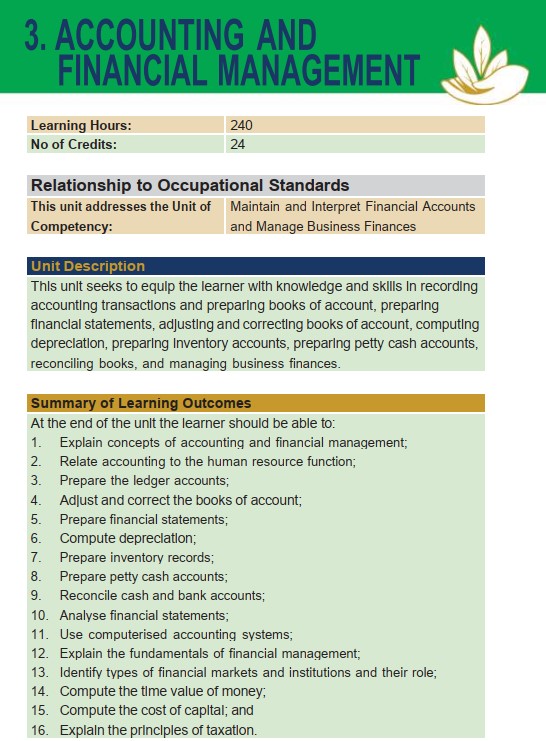
1. Explain the Concepts of Accounting and financial Management
1.1 Introduction to accounting and financial Management
1.2 Objectives of accounting and financial management
1.3 Accounting principles – Concepts and conventions
1.4 Accounting cycle
1.5 Accounting equation
1.6 Types of accounts
1.7 Book keeping systems
1.7.1 Single entry book keeping
1.7.2 Double entry book keeping
2. Relate Accounting to the Human Resource Function
2.1 Concepts of profitability, organisational sustainability and employee welfare
2.2 Users of financial statements and their needs
2.3 Impact of human resource costs on profitability
2.4 Link between the accounting and human resource functions
3. Prepare the Ledger Accounts
3.1 Introduction to the principles of bookkeeping
3.2 Journal entries
3.3 Ledger accounts
3.4 Trial balance extraction
4. Adjust and Correct the Books of Account
4.1 Identification and correction of errors
4.2 Adjustments for prepayments and accruals
4.3 Preparation of adjusted trial balance
4.4 Closing entries of the books of accounts
5. Prepare Financial statements
5.1 Preparation of financial statements for sole proprietors, partnerships, companies, non- profit making institutions
5.1.1 Income statement
5.1.2 Statement of financial position
5.1.3 Cashflow statement
5.1.4 Statement of changes in equity
6. Compute Depreciation
6.1 Concept of depreciation
6.2 Methods of depreciation;
6.2.1 Straight line
6.2.2 Reducing balance
6.2.3 Sum of years
6.2.4 Units of production
6.3 Accounting for depreciation in the income statement and statement of financial position
6.4 Impact of Depreciation on cash flow and income tax
7. Prepare Inventory Records
7.1 Inventory accounting systems
7.1.1 First in, last out
7.1.2 Average cost
7.1.3 Last in, first out
7.1.4 Periodic inventory systems
7.1.5 Perpetual inventory systems
7.2 Valuation of inventory
7.3 Accounting for inventory in financial statements
8. Prepare Petty Cash Accounts
8.1 Purpose of petty cash
8.2 Types of petty cash books: Columnar, imprest
8.3 Preparation of petty cash book
8.4 Controls on petty cash
9. Reconcile Cash and Bank Accounts
9.1 Importance of bank reconciliations
9.2 Process of preparing bank reconciliations; adjustments for various items
10. Analyse Financial Statements
10.1 Classification of accounting ratios
10.2 Importance of ratio analysis
10.3 Computation of ratios
10.4 Limitations of ratio analysis are explained
11. Use Computerised Accounting Systems
11.1 The role of computers in preparing financial accounts
11.2 Application and accounting softwares in the accounting process
11.3 The process of generating computerised accounts benefits and challenges of computerised accounting systems
Topic Content
12. Explain the Fundamentals of Financial Management 12.1 The nature and scope of finance
12.2 The relationship between accounting and finance
12.3 Role of a financial manager
12.4 Internal and external sources of business finance
13. Identify Types of Financial Markets and Institutions and their Role
13.1 Types of financial markets and institutions
13.2 Functions of financial markets
13.3 The flow of funds in financial systems
13.4 The role of the government in financial systems
14. Compute the Time Value of Money
14.1 The concept and relevance of time value of money
14.2 Discounting techniques
14.3 Payback period
14.4 Net present value
14.5 Internal rate of return
14.6 Loan amortisation schedules
15. Cost of Capital is Computed 15.1 The concept of cost of capital
15.2 Factors influencing the cost of capital
15.3 Computation of cost of capital for share capital, loan capital in small, non-complex entities
16. The Principles of taxation are Explained
16.1 Types of taxes
16.2 The process of computing taxes
16.2.1 Individual Income tax
16.2.2 Corporate tax
16.2.3 Value Added Tax
16.3 Tax reliefs
16.4 Tax remission
16.5 Offences and penalties
